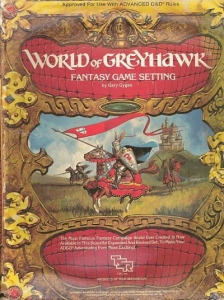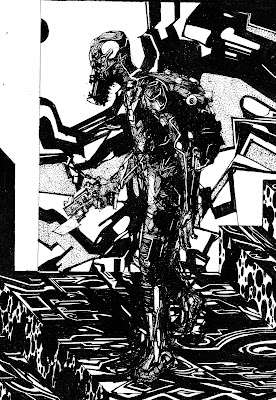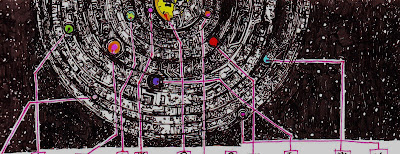So Eclipse Phase has this cool transhuman idea that you switch bodies ("re-sleeving"), unfortunately almost everything else about it sucks--the system, the art, the graphic design--so me and Kirin invented a new more Old School game of transhuman post-scarcity hard sci-fi star horror that we're gonna play on Thursdays. It's based on
Gigacrawler.
GIGACRAWLER:
BRAIN DAMAGE PHASE*
an old school game of transhuman post-scarcity hard sci-fi star horror
copyright Zak and Kirin today but you can play it
Character generation: Brain
First you'll want a brain, here are your choices:
Human brain, starting sanity points: 20
AI, starting sanity: 22
Psionic human, starting sanity: 17
Uplifted Animal brain, starting sanity: 18
You can obviously invent more kinds of brains like alien species and stuff but we're starting with these.
In addition to sanity points, your brain has some other stats. These 3 are familiar and self-explanatory:
Intelligence
Charisma
Perception
You get to rank one of these at +2, one of them at +1 and one of them at +0. Pick! If you have an AI brain you can rank Intelligence at +3 and the others at +0 if you want, if you have an Uplifted Animal brain you can rank Perception at +3 and the others at +0 if you want.
You also get some traits which describe both your personality and your resistance to losing sanity for different reasons. These are paired:
Biostubborn vs bioflexible-- Biostubborn means you're very comfortable in your body. Getting hurt doesn't freak you out but switching bodies does. Bioflexible means you're totally a cool anarchist about sprouting extra limbs and shit but you have a hard time handling damage to your body.
Biostubborn and Bioflexible are each rated on a scale of +0 through +10 and together must add up to +10. So you can have each at +5 or have +3 Biostubborn, +7 Bioflexible, or +10 Biostubborn, +0 Bioflexible, etc.
Psychostubborn vs Psychoflexible-- Psychostubborn means you're clear in your sense of self. It's hard for you to go insane from having your (biological or electronic) brain messed with but it's also hard for you to adapt to new information. Psychoflexible means it's easy to download new information but your sense of self is weak, so you have a hard time handling intrusion into your mind.
Psychostubborn and Psychoflexible are each rated on a scale of +0 through +10 and together must add up to +10. So you can have each at +5 or have +3 Psychostubborn, +7 Psychoflexible, or +10 Psychostubborn, +0 Psychoflexible, etc.**
You also get 4 points to spend on the last two things: Knowledges and your Familiar. If you are psionic you can use them on psionic abilities instead.
Knowledges are packages of information skills you can buy to start with for your brain. These start out broad and are technical things (ie only cover things that not all people can try, like there's no swimming or dodging skill because anyone can try to swim or dodge). Each Knowledge costs one point, they are:
Alien cultures
Animal handling
Astronomy & Astrophysics
Biology & Genetics
Chemistry
Craft/Hobby (specify)
Demolitions
Geology & Earth sciences
Hacking & Computers
Human cultures
Language (specify)
Mechanics & engineering
Medicine
Piloting
Psychotherapy
Thief (Analog intrusion, like lock picking)
Tracking
Psionics only:
Calm (advantage to San checks for someone near by) (Cha roll)
Counter (block other psionics) (Int roll)
Danger sense (Per roll)
Influence (like Charm Person) (Cha roll)
Read surface thoughts (Per roll)
Suggestion (basically as D&D spell) (Cha roll)
Hey Kirin, invent more psionic powers -Z
You also have a Familiar (like what is called in E Phase, a Muse) which is a personal AI that hangs out with you, it is full of software designed to help you not be murdered. It has two stats:
Knowledgebank--This is how big and well-designed the AI's program of downloadable skills and information is. The better this trait, the better the chance your AI can get you information and abilities compatible with your neural net. Downloading knowledge isn't instantaneous and requires a mental flexibility check or results in lost sanity (see rules below for details).
Printer--This is how good at creating and locating useful equipment out of local materials your familiar is when it's hooked up to the proper equipment. If you need a shotgun or a grappling hook or something and haven't already explicitly collected one, you roll on this trait to see if your 3d printer has prepared one for you. Downloading knowledge isn't instantaneous (see rules below for details).***
The bank and printer are rated +0, +1, or +2--your choice, but come out of the same pool from which you buy starting Knowledge. So you can choose to have +2 in Knowledgebank and +2 in Printer but have 0 Knowledges to start or you can have, say, Medicine and Piloting and +0 in Knowledgebank and +2 to Printer.
If you choose a body that does not match your brain, you get 5 additional points to add to this pool because you're presumably experienced and on at least your second body.
Speaking of choosing bodies....
Character generation: Body
You choose a body from a GM-provided list of available bodies. Different planets have different bodies available at different moments.
Each body has some familiar stats again, they usually start out rated +0, +1, or +2:
Strength
Attack (covers shooting and close combat)
Dexterity
Armor
Armor is almost always +2. With humans and most other organics this represents some removable armor, with robots this is something built in.
There is another stat called Defense which is just Dex+Armor.
Each body also has saving throws, based on what it's made of, ranked +0 thru +10, these are:
Exposure save (drowning, in a vacuum, etc--organics are especially vulnerable)
Corrosive save (
always = armor x 3)
Electromagnetic save (machines are especially vulnerable)
Each body also has special abilities called Advances.
-The first time you move into a new body you get to choose one advance.
-Each time you finish a mission or otherwise "get XP" you get to buy one advance from your body's list. (Also see "Leveling up" below).
-If you start the game with a brain and body that match, you get all the Advances for that body--it's your body.****
Advances are typically either things that offer a situational +2 to ability rolls (like you are extra good with knives: +2 to knife combat or piloting in-atmosphere craft: +2 to Dex rolls doing that), a +1 to an ability, or powers/aptitudes that allow you to do things nobody without the aptitude can do (like climb walls like a fly).
Some Advances are Permanent--that is, they stay with you even after you switch bodies.
Sample Bodies:
Genetically optimized human
Strength +1
Attack +2
Dexterity +1
Armor +2 (while wearing armor)
Defense +3
Exposure save +4
Corrosive save +6
Electromagnetic save +8
Advances:
+1 to Int (Permanent)
+1 to Per (Permanent)
+1 to Cha (Permanent)
+1 to Dex (Permanent)
+2 to Exposure save (Permanent for any organic body)
Caul-V-series warmech
Strength +2
Attack +2
Dexterity +0
Armor +3
Defense +3
Exposure save +8
Corrosive save +6
Electromagnetic save +2
Advances:
+1 to Attack (Permanent)
+2 to Attack with rifles (Permanent)
+1 to Printer (Permanent)
+1 to Armor
+2 to Psychoflexible (Permanent) (results in a -2 to Psychostubborn)
Crawler (Stealth-Optimized, Uplifted Langur Monkey)
Strength +0
Attack +1
Dexterity +2
Armor +2 (while wearing armor)
Defense +5
Exposure save +2
Corrosive save +6
Electromagnetic save +8
Advances:
+1 to Dex (Permanent)
+2 to Dex in stealth situations (non-Permanent)
+1 to Attack, Defense and Dex in zero-G (Permanent)
+1 more to Attack, Defense and Dex in zero-G (non-permanent)
+2 to Mechanics and engineering if used for sabotage (Permanent)
Observation droid
Strength +0
Attack +0
Dexterity +2
Armor +1
Defense +3
Exposure save +8
Corrosive save +6
Electromagnetic save +2
Advances:
+1 to Per (Permanent)
+2 to Dex rolls for stealth
+1 to Dex rolls for stealth (Permanent)
+3 to Bioflexible (Permanent) (results in a -3 to Biostubborn)
Chameleoid (Humanoid with chameleon DNA)
Strength +0
Attack +0
Dexterity +1
Armor +2 (while wearing armor)
Defense +3
Exposure save +2
Corrosive save +6
Electromagnetic save +8
Advances:
+4 to Dex in stealth situations due to changing skin color
+2 to Dex for climbing
+1 to Dex (Permanent)
Chameleoid dermographic language (Understanding is permanent, but being able to "speak" the language requires a body with an appropriate skin)
Pilot Chameleonoid vessel (Permanent)--Chameleonoid vessels have a unique color-coded control system layout. This is essential a specialist Knowledge.
In our games, the GM will make some more bodies available depending on the mission, but if you want to play right now, feel free to make your own. Remember if you start with a brain native to your body you get all the advances, so don't give any one body too many. Though some bodies are just better than others, period.
Task Resolution
Generally you roll a d12+modifiers to do anything where failing might have interesting consequences.
Most rolls are opposed, like you roll d12+Int to hack something and the GM rolls d12+however good they think the countermeasures are to resist you. High roll wins. However, the GM can also assign a static target number in situations where the thing isn't fighting back, depending how hard it is. If a character has some issue that makes things especially hard or easy for it specifically (ie swimming this lake of goo is normally a difficulty of 8 but it's especially hard if you're a dog) then the GM may use 5e-D&D style "advamtage" or "disadvantage".
Use of Knowledges and most Psi powers are an ability check that is simply enabled by having the Knowledge. So a "Chemistry check" is an Int check that you get to make because you have Chemistry. It's possible to have a Knowledge enable more than one kind of ability score check: a GM could rule that diagnosing a disease is a Int check (enabled by Medicine) but performing surgery is Dex (enabled by Medicine).
Again: Knowledges are specialist things--you can't even try piloting most craft if you don't have the pilot Knowledge.
Urgent Task Resolution and Combat
Since this is horror, combat in this game more follows the Call of Cthulhu "figure out something big before you die" model than the "ranges and damage spreads matter a lot" model of like D&D and wargames. In any situation where you need to do
this before someone else does
that (usually combat) there is no initiative, rather there's a "clash" system.
Think of a clash like a panel in a comic book. Each clash involves opposed rolls. It takes about 6 seconds.
Basically everyone says what they want to do. Then they roll a d12, high roll gets to do what they want. In complex combats with multiple participants, if you don't roll high but your task wouldn't be interrupted by anyone rolling higher than you, you can do it, you do your thing.
Typical combat involves an attack (Attack score + d12) vs either another attack (Attack vs d12) or dodging, running away, etc (Defense + d12). You could also have like an attack (Attack score + d12) vs an attempt the hack the weapon making the attack (Int + d12, only possible if the combatant has Hacking).
There's no variable damage--this is a harsh post-scarcity future and if you are using a weapon strong enough to get through the enemy's armor (or lack thereof) the enemy is gonna get fucked up. If you aren't, nothing happens.
You go straight to the crit table at the bottom of this entry every time you get hit. (It's basically an adapted version of
this.)
Example: If a regular person punches another person in (22nd century nanospace-)armor, nothing happens--they have crazy future armor and the armor is preposterously out of scale to the attack. If they punch a regular person in
no armor successfully, that is doing damage and you roll a crit. Combat is fast and deadly.
If you roll less than a 50 on that table, you need to also make a Psychostubborn check (difficulty 10) to avoid losing d4 sanity points.
The winner of a clash gets to decide the range at the beginning of the next clash. So if you successfully shoot someone you can decide the next round starts with you far away (you are hit, I can make my getaway) or close up (you are hit! I can now come over and finish you off). The max distance you can move away is 60 feet unassisted.
If the goal of the combat action was not to do damage--like you wanted to knock someone down or take something or whatever--then, again, winner does that.
If the situation is such that one side would naturally have an advantage (you're fighting in a tiny broom closet and one person has a knife and the other has a sword, so the knife is a better weapon) then the GM can grant 5e-style Advantage (roll twice, pick the highest).
Note that because Defense involves adding Armor to Dex, maneuvers where armor wouldn't matter (grappling, pickpocketing) are just against Dex.
Area-effect weapons and environmental conditions can trigger body saving throws--failing one of these save does one of three things:
-Kills you
-Inflicts a specific kind of damage unique to that kind of effect (ie exposure to this radiation makes your eyes melt shut)
-Causes a roll on the Crit table
The GM is encouraged to design bizarre puzzle-monster postLovecraftian boss foes that require more than physical force to put them down.
Weapons and Equipment
This isn't a
Spidergoat Economy, your Printer provides you with weapons capable of dealing with ordinary threats provided you make your Printer roll and they fit the tech level/aesthetic of the game (kinda hard science fi, except some people are psychic?). You need a grenade? Make a Printer roll to see if you managed to download specs from the Aether and get one properly made. You need a neutron grenade specifically, to kill the organics but leave the ship intact? The GM might make that a higher difficulty number check, maybe an 11.
This isn't always a check to see if you can print it--printing takes at least a number of minutes equal to the difficulty of the check times 2 in minutes. It's a check to see if you were prepared enough to have the thing already.
Downloading New Knowledges
This takes one minute and a successful Knowledgebank check, difficulty 8. A successful download requires the PC to make a difficulty 8 Psychoflexible check or lose d4 San, if it's a new language it's only difficulty 6.
Healing
This will mostly be dealt with on the crit chart, but mechanical repair or medicine can be used to fix crits but it takes time and can't be done in a tactical situation.
Dying
Dying happens if you take a bad crit. Then you get re-sleeved as your brain is emailed somewhere and downloaded into a new body in the nearest friendly cache. You have to make a Bioflexible check or you lose d6 Sanity in the process. The difficulty number depends on the new body:
Body matches brain: 6
Previously-experienced type of body: 8
First time humanoid, first time non-humanoid, first time organic: 10
First time machine: 12
First time machine
and first time humanoid/non-humanoid simultaneously: 14
Other: 9
Sanity
You'll roll lots of Sanity checks--this is a horror game. GM decides how bad the San loss is--d4, d6, d8, etc.
Losing more than 3 sanity on one roll or in one hour results in a temporary insanity from the table at the back of most editions of Call of Cthulhu. It lasts until things quiet down and someone either administers Psychotherapy (with a difficulty number = 20 minus current San score) or the victim makes a successful Craft/Hobby roll or you level up and choose the option to fix your sanity. This recovers d4 San and cures the condition.
You lose all your sanity points and you're permanently insane and an NPC.
Leveling up
Every time you've completed a mission (GM decides what that means) you can do one of three things:
-Take an Advance from your body's list of advances. You may only take each once, though some are listed in alternate forms, permanent and nonpermanent and/or with different numbers--you can take each form once.
-Gain d4 San
-Take a new Knowledge
-Take a specialty Knowledge (that is, any custom Knowledge narrower than you already have) at +1. So, like, if you already have Hacking. you could take Neural Net Hacking +1. And if you already have Neural Net hacking you could take Neural Net hacking of Military AIs at +1. These stack and apply to the rolls you make with them.
You don't have to roll a Psychoflexible check to gain these knowledges or specialties, they're learned the old fashioned way.
Max on anything in any situation is +10.
------
Crit table
Losing a body part your body used to have but don't now means instant death (so the more mutilated you become the more dangerous combat is). Losing a body party (or equivalent) your body never had means instant death if you're larger than human sized or you've evaded the crit if you're smaller and if you're human size, roll a dex check (8), failure means death, success means you've avoided damage.
1-Adrenaline surge, or auxiliary program activates, you are +1 to Comabt then collapse for d6 clashes when the fight ends plus awesome scar, +1 Cha.
2-Adrenaline surge or auxiliary program activates, you are +1 to Combat then collapse for d6 clashes when the fight ends.
3-Awesome scar, +1 Cha
4-Scar
5-Ugly scar -1 Cha
6 Lose a tooth, or equivalent
7 Lose some teeth or equivalent in an unbecoming place -1 Cha
8 Str check vs 10 or be knocked down, conscious
9 Successful medicine check (8) next clash or lose right eye or equivalent
10 Successful medicine check (8) next clash or lose left eye or equivalent
11 Successful medicine check (8) next clash or lose right ear or equivalent
12 Successful medicine check (8) next clash or lose left ear or equivalent
13 Successful medicine check (8) next clash or lose tongue or equivalent
14 Lose right eye or equivalent
15 Lose left eye or equivalent
16 Lose right ear or equivalent
17 Lose left ear or equivalent
18 Lose tongue or equivalent
19 Lose d6 fingers on left hand (6= just thumb) or equivalent
20 Lose d6 fingers on right hand (6= just thumb) or equivalent
21 Embarassing injury (permanent) (player's choice)
22 Lose your nose or equivalent unless the player decides this makes the pc unplayable in which case be a softie and let them pick a facial feature.
22 Biostubborn check (10) or be stunned only able to defend) for 5 clashes (or until proper full-on medical care) then conscious.
23 Biostubborn check (10) or be stunned...
24 Biostubborn check (10) or be stunned...
25 Biostubborn check (10) or be stunned…
26 Biostubborn check (10) or be stunned...
27 Biostubborn check (10) or go unconscious for 1clash (or until proper full-on medical care) then conscious.
28 Biostubborn check (10) or go unconscious for 2…
29 Biostubborn check (10) or go unconscious for 3…
30 Biostubborn check (10) or go unconscious for 4…
31 Biostubborn check (10) or go unconscious for 5...
32 Unconscious 1 clash (or until proper full-on medical care) then conscious.
33 Unconscious 2 clashes (or…
34 Unconscious 3 clashes (or…
35 Unconscious 4 clashes (or…
36 Unconscious 5 clashes (or...
37 Unconscious 1 clash (or until proper full-on medical care), then conscious and disadvantage until successful Medicine check at 6
38 Unconscious 2 clashes (or...
39 Unconscious 3 clashes (or...
40 Unconscious 4 clashes (or…
41 Unconscious 5 clashes (or ...
42-51 Unconscious until Medicine check (8) is made.
52 Neck damage Biostubborn check vs 6 or go unconscious for d4 clashes (or until proper full-on medical care), then back to conscious and disadvantage on all physical checks. d4 days to recover without proper full-on medical attention.…
53 Head fracture Biostubborn check...
54-55 Broken something in pelvis Biostubborn check...
56-59 Broken something in ribs Biostubborn check...
60 Broken something in left hand Biostubborn check...
61 Broken something in rt hand Biostubborn check...
62-63 Broken something in in left leg Biostubborn check...
64 Broken something in in rt leg Biostubborn check...
65 Broken something in in left foot Biostubborn check...
67 Broken something in in rt foot Biostubborn check...
68 lost use of right hand Biostubborn check vs 6 each clash to keep conscious until successful Medicine check vs 6 (-1 Dex when moving for missing appendage). d4 days to recover without proper full-on medical care but even then you're still maimed.
69 lost use of left hand Biostubborn check...
70 lost use of right foot Biostubborn check…
71 lost use of left foot. Biostubborn check...
72 lost use of left arm past elbow die in 30 minutes unless Medicine check (difficulty 8). Medicine check keeps you conscious with a Biostubborn check vs 8 each clash to keep conscious (-1 Dex for mangled limb). Week to recover without proper full-on medical care but even then you're maimed.
73 lost use of right arm past elbow die in 30 minutes unless...
74 lost use of right leg below knee die in 30 minutes unless…
75 lost use of left leg below knee die in 30 minutes unless…
76 lost use of right arm die in d4 minutes unless Medicine check (difficulty 8). Medicine check keeps you conscious with a Biostubborn check vs 8 each clash to keep conscious (-1 Dex for lost limb). Two weeks to recover without without proper full-on medical care but even then yr still missing a limb.
77 lost use of left arm die in d4 minutes unless...
78 lost use of right leg die in d4 minutes unless…
79 Lost use of left leg. Die in d4 minutes unless…
80 Internal injuries. Die in 30 minutes unless Medicine check (difficulty 8). Medicine check leaves you conscious with a Biostubborn check vs 8 each clash to keep conscious (with disadvantage on physical checks)--a month to recover without proper full-on medical care.
81 Die in 25 minutes unless Medicine etc...
82 Die in 20 minutes unless Medicine etc…
83-84 Die in 15 minutes unless…
85 Internal injuries, unconscious. Die in 30 minutes unless successful Medicine (difficulty 10) (with disadvantage on physical checks). A month to recover without proper full-on medical care.
86 Die in 25 minutes unless…
87 Die in 20 minutes unless…
88 Die in 15 minutes unless…
89 Die in 10 minutes unless ...
90-97 Internal injuries, unconscious. Die in d12 clashes unless Successful Medicine (difficulty 10) check this clash against and even then you're at disadvantage on everything physical. A month to recover without proper full-on medical care.
98 Instant death
00 Instant and demoralizing death. Allies roll Bioflexible vs 8 or be stunned for one clash.
Character sheet:
-----
*
(Working title)
**The ides of paired mental traits is stolen from Pendragon
***This post-scarcity equipment solution stolen from the "Preparedness" skill in Night's Black Agents
****The concept of bodies as things you serially buy advances from is derived from the Warhammer Fantasy career system. Which might itself be derived from Traveller?



































